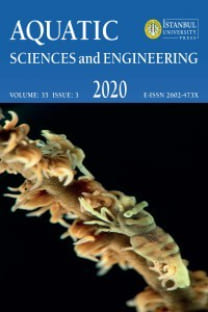First record of Cotylorhiza tuberculata (Macri, 1778) from the Sea of Marmara
Jellyfishes, which are one of the most important consumers in marine ecosystems, may have detri-mental effects on fish stocks that have economic value. Therefore, identifying and monitoring jelly-fish presence is important. We observed four individuals of symbiotic rhizostome scyphozoan Cot-ylorhiza tuberculata in the vicinity of the Princes’ Islands Archipelago, in the Northeast Sea of Marmara, Turkey in September 2020. Although this species is a common member of gelatinous plankton in the Mediterranean Sea, the present study is the first record from the Sea of Marmara.
Keywords:
Cotylorhiza tuberculata, rhizostomae scyphomedusae, jellyfish, Sea of Marmara,
___
- Alparslan, M., Doğu, S. & Özalp, B. (2011). Importance of Jellyfishes and Their Distribution around the Çanakkale Strait. In Workshop on Jellyfish and Other Gelatinous Species in Turkish Marine Waters 20-21 may 2011 (p. 78). ISBN: 978-975-8825-27-1
- Astorga, D., Ruiz, J. & Prieto, L. (2012). Ecological aspects of early life stages of Cotylorhiza tuberculata (Scyphozoa: Rhizostomae) affecting its pelagic population success. In Jellyfish Blooms IV (pp. 141-155). Springer, Dordrecht. DOI:10.1007/s10750-012-1036-x
- Balık, S. (1973). İzmir Körfezi ye Civarında Bulunan Deniz Analarının (Scyphozoa, Coelenterata) Taksonomik ye Ekolojik Özellikleri Üzerine Araştırmalar. - Ege Üniversitesi Fen Fakültesi ilmi Raporlar Serisi, no. 179: 1-15, İzmir.
- Benovic, A. & Lucic, D. (2001). Jellyfish outbreaks: natural cycle or stress response effect. In Gelatinous zooplankton outbreaks: theory and practice. CIESM Workshop Series, Monaco, Vol. 14, pp. 59-63. Retrieved from https://ciesm.org/catalog/index.php?article=1014 (accessed 02.02.20)
- Bilio, M. & Niermann, U. (2004). Is the comb jelly really to blame for it all? Mnemiopsis leidyi and the ecological concerns about the Caspian Sea. Marine Ecology Progress Series, 269, 173-183.
- Boero, F. (2013). Review of jellyfish blooms in the Mediterranean and Black Sea. General Fisheries Commission for the Mediterranean. Studies and Reviews, (92), I.
- Brodeur, R. D., Suchman, C. L., Reese, D. C., Miller, T. W. & Daly, E. A. (2008). Spatial overlap and trophic interactions between pelagic fish and large jellyfish in the northern California Current. Marine Biology, 154(4), 649-659.
- Ferguson, H., Delannoy, C., Nicolson, J., Sutherland, D., Crumlish, M. & Hay, S. (2009). Jellyfish as vectors of bacterial disease for farmed fish. Nature Precedings, 1-1.
- Graham, W. M. & Bayha, K. M. (2008). Biological invasions by marine jellyfish. In Biological invasions (pp. 239-255). Springer, Berlin, Heidelberg. ISBN 978-3-540-77375-7
- Gulsahin, N. & Tarkan, A. N. (2013). Seasonal distribution of Scyphozoa (Cnidaria) and Ctenophora species in Gökova Bay, Mugla, Turkey. Rapp Comm int Mer Médit, 40, 538.
- İnanmaz, Ö. E., Bekbolet, M. & Kıdeyş, A. E. (2002). A new scyphozoan species in the Sea of Marmara: Chrysaora hysoscella (Linné, 1766). Oceanography of the Eastern Mediterranean and Black Sea. Ankara, Turkey, TÜBİTAK, pp. 857-859.
- Isinibilir, M. & Yılmaz, İ. N. (2017). Jellyfish dynamics and their socioeconomic and ecological consequences in Turkish Seas. Jellyfish: Ecology, Distribution Patterns and Human Interactions, 51-70.
- Isinibilir, M., Tarkan, A. N. & Kideys, A. E. (2004). Decreased levels of the invasive ctenophore Mnemiopsis in the Marmara Sea in 2001. In Aquatic Invasions in the Black, Caspian, and Mediterranean Seas (pp. 155-165). Springer, Dordrecht. ISBN 978-1-4020-2152-7
- Isinibilir, M., Yilmaz, I. N. & Piraino, S. (2010). New contributions to the jellyfish fauna of the Marmara Sea. Italian Journal of Zoology, 77(2), 179-185.
- Kikinger, R. (1992). Cotylorhiza tuberculata (Cnidaria: Scyphozoa)‐Life history of a stationary population. Marine Ecology, 13(4), 333-362.
- Kramp, P. L. (1961). Synopsis of the medusae of the world. Journal of the marine biological Association of the United Kingdom, 40, 7-382.
- Macrì, D.S. (1778). Nuove osservazioni intorno la storia naturale del polmone marino degli antichi. Retrieved from http://books.google.it/books?id=wJw-AAAAcAAJ&printsec=frontcover&dq= inauthor:%22Saverio+MACRI%22&hl=it&sa=X&ei=vFiSUYrAJ8Ku7AbJk4H4BA&ved=0CE AQ6AEwAg#v=onepage&q&f=false (accessed on 02.10.2020).
- Mills, C. E. (2001). Jellyfish blooms: are populations increasing globally in response to changing ocean conditions?. Hydrobiologia, 451(1-3), 55-68.
- Nunes, P. A., Loureiro, M. L., Piñol, L., Sastre, S., Voltaire, L. & Canepa, A. (2015). Analyzing beach recreationists’ preferences for the reduction of jellyfish blooms: Economic results from a stated-choice experiment in Catalonia, Spain. PloS one, 10(6), e0126681.
- Öztürk, B., Topaloğlu, B., Sümen, S.G., Turan, C., İşinibilir, M., Aktaş, Ş. & Özen, Ş. (2018). Jellyfish of the Black Sea and Eastern Mediterranean Waters. Turkish Marine Research Foundation (TUDAV) Publication No.48, Istanbul, Turkey pp. 75. ISBN 978-975-8825-40-0
- Pérez-Ruzafa, A., Gilabert, J., Gutiérrez, J. M., Fernández, A. I., Marcos, C. & Sabah, S. (2002). Evidence of a planktonic food web response to changes in nutrient input dynamics in the Mar Menor coastal lagoon, Spain. In Nutrients and Eutrophication in Estuaries and Coastal Waters pp. 359-369. Springer, Dordrecht. ISBN 978-90-481-6123-2
- Prieto, L., Astorga, D., Navarro, G. & Ruiz, J. (2010). Environmental control of phase transition and polyp survival of a massive-outbreaker jellyfish. PloS one, 5(11), e13793.
- Purcell, J. E. & Arai, M. N. (2001). Interactions of pelagic cnidarians and ctenophores with fish: a review. Hydrobiologia, 451(1-3), 27-44.
- Richardson, A. J., Bakun, A., Hays, G. C. & Gibbons, M. J. (2009). The jellyfish joyride: causes, consequences and management responses to a more gelatinous future. Trends in ecology & evolution, 24(6), 312-322.
- Yilmaz, I. N., Isinibilir, M., Vardar, D. & Dursun, F. (2017). First record of Aequorea vitrina Gosse, 1853 (Hydrozoa) from the Sea of Marmara: a potential invader for the Mediterranean Sea. Zoology in the Middle East, 63(2), 178-180.
- Yayın Aralığı: Yılda 4 Sayı
- Başlangıç: 1987
- Yayıncı: İstanbul Üniversitesi
Sayıdaki Diğer Makaleler
Maximum size of Marbled spinefoot (Siganus rivulatus Forsskal & Niebuhr, 1775) for Aegean Sea
Ozan SOYKAN, Anıl GÜLŞAHİN, Hasan CERİM
Emre BABUR, Ömer Süha USLU, Cafer YILMAZ, Muhammet SÜNBÜL
Melek İŞİNİBİLİR, Esin YÜKSEL, Cem DALYAN
Suleyman Fatih OZMEN, Olgaç GÜVEN
Emre BABUR, Turgay DİNDAROĞLU, Cafer YILMAZ, Muhammet SÜNBÜL
Ozan SOYKAN, Anıl GÜLŞAHİN, Hasan CERİM
Menekşe TAŞ DİVRİK, Meliha ÖZ LAÇİN, Kadir KALKAN, Sinan YURTOĞLU
Emre BABUR, Turgay DİNDAROĞLU, Cafer YILMAZ, Muhammet SÜNBÜL
